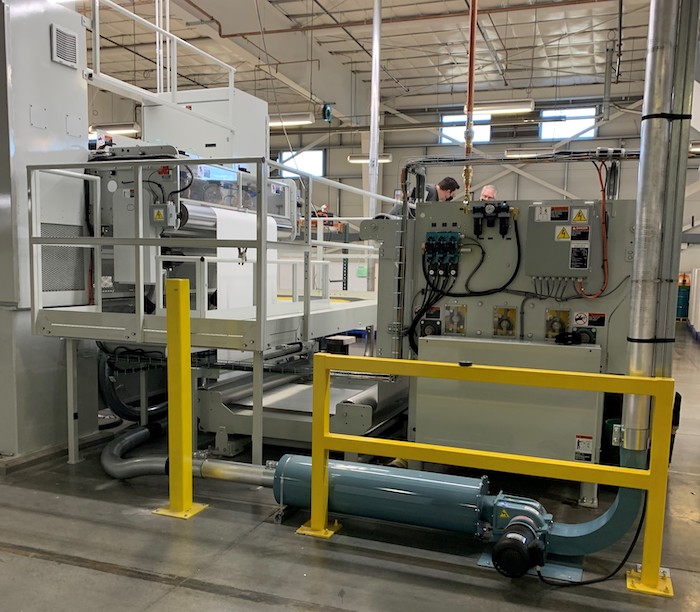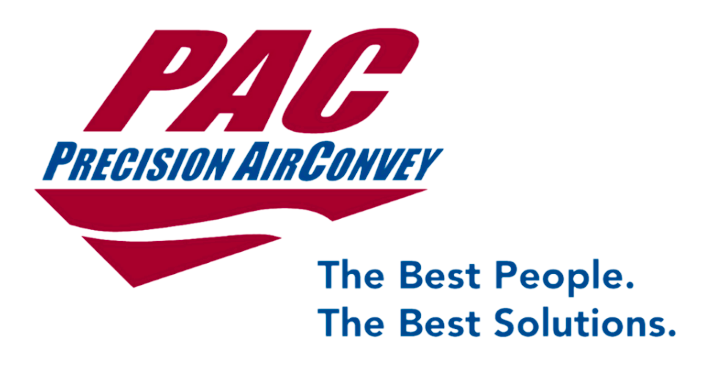
Reducing noise and dust while maximizing speed and capacity with PAC’s cutter trim removal system.
Packaging manufacturers know only too well the myriad problems that come with traditional trim removal systems. Inefficient, cumbersome, and loud, most trim removal systems are susceptible to jams, snags, and clogging in the ductwork — leading to major production delays that come with major costs.
A leading manufacturer of custom die-cut packaging based in Salt Lake City, Utah PaperBox (UPB) had become intimately familiar with trim and waste removal issues. While in need of an edge trim removal system that would allow their sheeting department to operate at full capacity, they also knew that cutting corners wasn’t going to cut it. So, when Precision AirConvey (PAC) reached out to UPB to ask about their trim removal needs, the timing couldn’t have been more perfect.
“We had already been in contact with another company, so we were definitely in the market for a new system,” explains Mike Salazar, UPB’s Vice President of Operations. “We were so impressed with PAC’s response time, level of service, and the care they put into understanding our unique requirements, there was no question. We went with PAC.”
PAC scheduled an in-person tour of UPB’s plant to get an up-close look at their machine, space, set-up, and needs. “We saw that the distance between the sheeter and the bale handling area was quite long and would require an innovative solution to create a path of least resistance,” recalls PAC CEO, Tom Embley. Adds PAC engineer, George Morales, “Our challenge was to provide the most direct route possible so that the trim and waste could reach its destination with zero clogs and jams, and maximum speed and efficiency.”
Chopper Vs. Cutter
PAC’s team of engineers quickly got to work designing UPB’s customized trim removal system using innovative processes. In place of a large, cumbersome chopper fan commonly used with most systems, PAC designed and installed smaller, ultra-sharp precision inline cutters to slice UPB’s large volume of edge trim into high-density, easy-to-convey pieces.
“Because of their large size, chopper fans don’t typically allow for an easy path from the trim nozzle to the fan,” explains Embley. “Chopper fans are big, which means they can’t be tucked away under a machine, or in a spot that’s ideal for trim pick-up. If you put the chopper fan close to the machine, it’s also going to be next to the operator who will be subjected to the fan’s noise.”
The compact size of PAC’s unique inline cutters meant that they could be positioned close to the equipment, enabling the cut-up trim to travel through the duct more efficiently and swiftly — without clogging, snagging, or jamming up. This also allowed PAC’s engineers and design team to create a less aggressive and more direct path to the pick-up point, which in turn allowed UPB to produce sheets faster.
“When you have heavy paper moving through the machine, handing all that trim is near impossible without cutting it up first,” explains Embley. “With their new PAC solution installed and running, UPB can now run their sheeter at maximum speed and collect the maximum amount of scrap without needing extra manpower to handle and haul it all the way across their plant.”
Cutting Down Noise and Dust
UPB fully expected their trim removal system to be loud; after all, that’s what the industry has come to expect. So, they were pleasantly surprised to discover that PAC’s unique solution was amazingly quiet while also being efficient. With PAC’s cutter trim removal system, the operator doesn’t have to worry about standing next to a deafening chopper fan. UPB was particularly concerned about installing a loud fan over their office and disrupting operations. PAC designed a solution to address this concern as well.
“We modified the system’s intake, moving the ducting underneath the equipment,” explains Morales. “We also used PAC’s propriety silencers to allow for a much quieter operation. And because we designed the system to extend the distance between the cutter and the material handling area, the operator doesn’t have to stand next to loud machinery.”
“The solution PAC designed and installed for us was dramatically quieter than our expectations,” agrees Salazar. “That was a definite plus.”
Cleanliness was another key consideration for UPB’s solution. “One step on their plant floor, and you could immediately tell that UPB runs an immaculate operation,” recalls Morales. “Dust and printing are like water and oil; they don’t mix.”
PAC designed UPB’s solution to convey edge trim and waste more than 400 feet across UPB’s plant to the separator for baling and dust collection, keeping fine dust particles far away from the print area. The waste is then deposited into a baler, or container for easy handling, recycling, or disposal. As an added bonus, the solution now makes it easier for UPB to maximize collection for premium recycled paper — opening additional revenue opportunities.
“PAC did a fantastic job understanding our unique requirements and challenges, and designing a solution that reduces noise levels, keeps our print area dust-free and clean, and makes it easier to handle and recover waste,” says Salazar. “Since installing our PAC cutter trim removal system, we’ve been able to keep our line running at full speed and capacity, while saving countless hours of labor in our sheeting department. PAC’s level of service has been exceptional, our investment is paying off, and we recommend them to any packager, manufacturer, or printer looking for a better way to remove trim and waste.”
